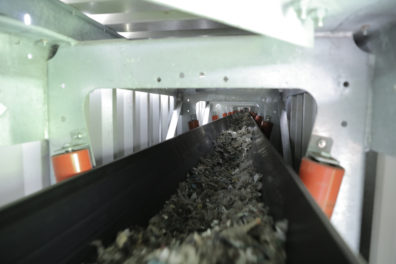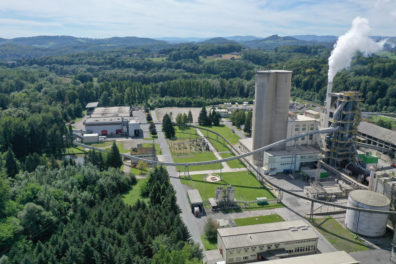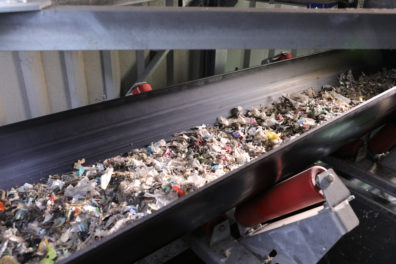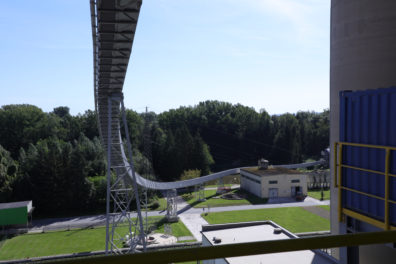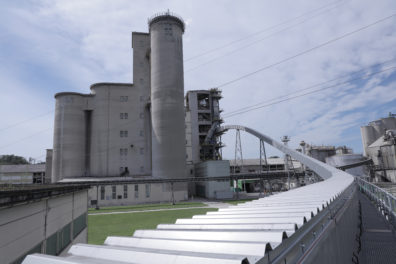BEUMER Group: U-shape conveyor combines the advantages of a troughed belt conveyor and those of a pipe conveyor
The U-shape conveyor allows the implementation of narrower curve radii than a troughed belt conveyor and higher mass flows than a pipe conveyor. At the same time and contrary to the troughed belt conveyor, it protects the material conveyed from environmental stress and the environment from material loss and emissions. Thus this u-shaped conveying solution has proven to be an ideal alternative in the cement and mining industry as well as in port terminals if high capacity is required with little space available.
Lafarge Zementwerke GmbH, a company of LafargeHolcim in Rapperswil-Jona/Switzerland, is located in Styria, Austria. The plant not only places particular emphasis on high-quality products, but also on sustainable, energy-efficient and environmentally-friendly production. Alternative fuels are therefore increasingly being used to fire the new calciner. “During the transport, the material should be protected against external influences such as wind, rain or snow and the environment against possible material loss and emissions,” says Karl Filarowski, Sales Director at BEUMER Group Austria. In addition, the conveyor should be able to transport both coarse material and very fine material. The BEUMER experts opted for a U-shape conveyor. “In this solution, a special idler configuration brings the belt in a u-shape,” describes Filarowski. Thus, the bulk material reaches the discharge station. An idler configuration similar to that for the shaping is used for opening the belt. Unique feature of this solution: It brings together the advantages of open troughed belt conveyors and closed pipe conveyors. “Our U-shape conveyor can be used in all industries, especially when large grain sizes have to be transported or the available space is not sufficient for an open troughed belt conveyor,” says the BEUMER expert.
Troughed belt conveyor or pipe conveyor?
“With our belt conveying systems, we design comprehensive system solutions for the mining and cement industries or in port terminals,” says Karl Filarowski. The troughed belt conveyors allow high mass flows even in case of heavy and robust materials. Their open design makes them suitable for coarse materials and very large volumes and permits to skim off the transported material in the rare event of overfilling. The simple design of these conveyors means they can be delivered and installed quickly and are also easy to maintain,” explains Filarowski. The proven components such as belt, idlers, pulleys and drives make sure that they work reliably and, depending on the depth of troughing, they can also be designed as curved overland conveyors.
The pipe conveyors on the contrary present other specific advantages. The idlers form the belt to a closed tube protecting the material transported against external influences and the environment from emissions such as material loss, dust or odours. Partition plates with hexagonal cuts and idlers in staggered arrangement keep the tube shape closed. “The pipe conveyors allow the implementation of narrower curve radii and larger angles of inclination than troughed belt conveyors,” says BEUMER expert Filarowski. The system requires little space and can be adapted to the topography of the terrain. As a consequence, the number of transfer towers and power supply units is reduced and the owner saves money. Either the troughed belt conveyor than the pipe conveyor permit a simultaneous transport of different materials in the upper and in the return strand.
U-shape conveyor instead of pipe conveyor
The closed pipe conveyors are suitable to protect fine material such as ash and ore concentrates or even household waste from external influences. The higher the requested conveying capacity has to be, the larger the whole system has to be dimensioned. The diameter directly affects the width of the conveyor and the minimum curve radius. What happens if the required space is missing? “We offer our U-shape conveyors in different versions. This depends on the respective application,” says Filarowski. The P-U-shape conveyor offers the functionalities of a pipe conveyor, but is also able to transport coarse materials. In this version the upper strand is formed to an U, while the return strand keeps its tubular shape. “This saves space and prevents loss of material,” explains Filarowski. This solution permits the owner to benefit from a significantly higher transport capacity with the same belt width compared to the pipe conveyor. Filarowski mentions an example: The pipe conveyor is a volumetric system. If we consider the starting basis of a tube diameter of 150 and a belt width of 600 mm, the conveying capacity amounts to 100 cubic metres per hour. The P-U-shape conveyor achieves a capacity of 170 cubic metres with the same size. “Thus we can offer the customer an approx. 70% higher conveying capacity”.
Often the owners think in advance to provide the running line with several feeding points. The closed pipe conveyor should open and close again at every single point. This requires additional mechanical components which cost money. “Our U-shape conveyor is open at the top and can therefore transport more material. A special cover can also be used to prevent the material or odours from escaping”.
U-shape conveyor instead of troughed belt conveyor
The T-U-shape conveyor, on the contrary, is suitable in case the owner relies on the advantages of a troughed belt conveyor, but has to consider the specific topographic conditions. This happens if for example narrower curve radii are required or if there are line sections, which require a thinner construction. This way it is for example possible to install a troughed belt conveyor for the routing outside the tunnel, and in the tunnel itself the design of the conveyor changes to a T-U-shape conveyor. “Compared to a troughed belt conveyor with a capacity of 500 tons per hour and a belt width of 650 mm, it is possible to achieve the same capacity with a T-U-shape conveyor saving 150 mm of space,” describes Filarowski. “The bigger the troughed belt conveyor, the bigger the related space saving”.
From the pipe conveyor to the U-shape conveyor
But what can be done if a plant is already using a pipe conveyor and the system does not achieve anymore the required capacity due to capacity expansions? “We are able to retrofit existing pipe conveyors to U-shape conveyors,” promises Filarowski. At this regard, the partition plate cut-out in the upper strand is enlarged as required to enable the optimal use of the existing conveyor width. The staggered arrangement with six idlers can be changed to five idlers allowing the belt to open automatically and form an U. At the same time the hexagonal cut-out in the return strand remains. Thus the belt runs in tubular shape and avoids loss of material on the running line. “For the modification we can re-use the existing components such as idlers and conveyor belt,” says the BEUMER expert. If an owner relies on a pipe conveyor and nevertheless wants to be prepared for future capacity expansions – with little space in the plant – BEUMER technicians can already consider an optional modification to an U-shape conveyor during the project planning.
We had exactly this case with an owner who intended to transport alternative fuels with a pipe conveyor. “We designed the steel structure like that of an U-shape conveyor with corresponding partition plates cut-outs in the upper strand,” reports Filarowski. The technicians additionally mounted adjusting pieces with idlers to ensure the tube shape of the pipe conveyor at the upper edge of the u-shaped cut-out. In case of modification, these adjusting pieces can be removed and the system retrofit. Thus a thin design with corresponding curve radii is kept. Special covers can be optionally mounted.
The ability to plan for a long term
“Our customers must always be able to react in flexible way on the market,” knows Karl Filarowski. “Higher capacities because of an increase in requirements, or modified products require future-oriented and tailor-made concepts to be successful in the long run”.
U-shape conveyors are therefore a safe investment, which can be easily integrated in an existing infrastructure.
